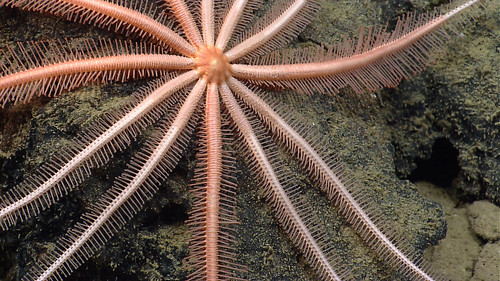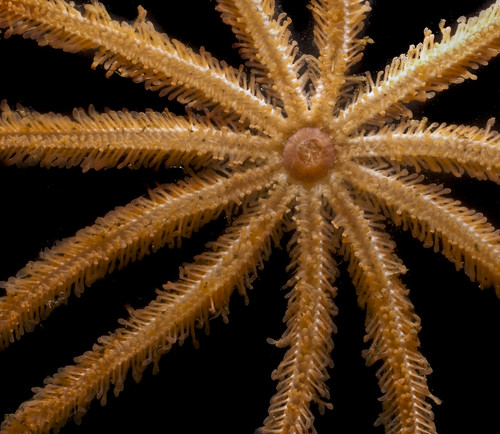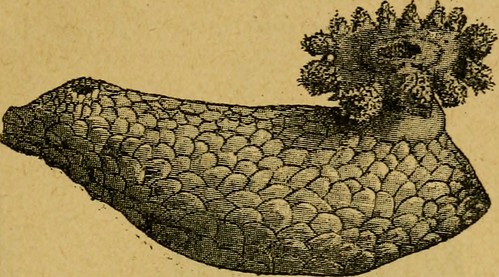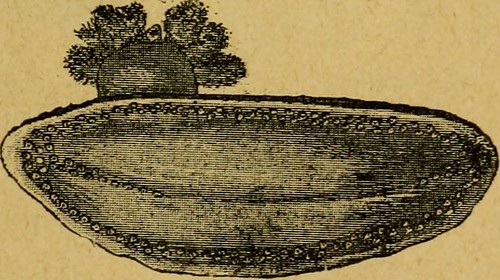 So, in thinking about Xyloplax, I was wondering WHAT is it exactly that seems to attract people to the really oddball animals.
So, in thinking about Xyloplax, I was wondering WHAT is it exactly that seems to attract people to the really oddball animals. I touched on some of the weirdness in the first Xyloplax post..but here are a few other aspects of the "Xyloplax Phenomenon" that is common to so many weird animals in the field...
1. Rarity
People are fascinated by the rare and rarely encountered. Xyloplax has 3 species-all found from distant locales at great depth. Until the one discovered in 2004, there was a 17 year gap until it was found again!!!
So, they ain't too common...Here's the breakdown:
- Xyloplax medusiformis. Described in 1986 based on less then a dozen specimens from New Zealand. AND found while people were looking for OTHER wood-living deep-sea critters...
- Xyloplax turneri. Described in 1987 based on over a 100 specimens, but oddly, collected in 1980 from the tropical Atlantic!!! Collected FIRST by Dr. Ruth Turner at the MCZ and then later published as the second Xyloplax species by Frank Rowe.

- Xyloplax janetae. Collected in 2004 (published in 2005) by Janet Voight at the Field Museum via sub from deployed wood-making it the FIRST time in 17 years it had been seen! There were 103 specimens of this species which I described as a new species in 2005. These specimens had some NICE brooding female specimens.
One of the other weird things..here is an animal that we have invested an enormous amount of energy in studying..but what do we ACTUALLY know about its biology? its ecology? What it eats in the morning? DOES it eat anything in the morning??
 There have never been any REAL published observed of this animal alive or even in situ!! What does it DO with those spines? Why doesn't it have a well-developed gut?
There have never been any REAL published observed of this animal alive or even in situ!! What does it DO with those spines? Why doesn't it have a well-developed gut? Some useful information was inferred from the tissue analysis (reproduction, etc.) but ultimately we know little about its life habits.
Xyloplax is like a wonderous, wonderous piece of mystery dessert..we don't know what's IN it..but we want to taste it because it seems to be SO tantilizing on the OUTSIDE....
3. History
Okay...so this is the big one and related to the MYSTERY. How do you GET such an extreme morphology? How does EVOLUTION get you from a starfish to whatever-the heck Xyloplax is??? the problems/challenges that have followed this issue are big ones, and hence the appeal...including:
- Homologies. What are the corresponding structures that have been modified over time? We can see forelimbs in fish and monkeys pretty easily but for echinoderms? Much more difficult. Several papers have argued and even redefined basic concepts of homology within Xyloplax.
- Morphology is Highly Derived. All the structures are SO far beyond what we see in other echinoderms..its hard to say exactly what kind of evolutionary "signal" gets through. What is an adaptation? What is an ancestral trait?
A. Non-Asteroid (i.e. Starfish) Relationships.
On one hand, there was serious consideration of Xyloplax's relationship within the Echinodermata. Is it a highly modified ophiuroid? a weird sea urchin?? a crazy modified sea cucumber?? REALLY a separate class all on its own???
One early but idea proposed that Xyloplax was possibly related to the Paleozoic Cyclocystoidea??
 Cyclocystoids were a weird group of disk-shaped echinoderms that lived in the Paleozoic and look kinda like cookies with a series of plates in a solid ring around the edge. Little is known about them other than that their appearance as being "medusoid" in shape with a structural ring around the edge and a bunch of plates in the center.
Cyclocystoids were a weird group of disk-shaped echinoderms that lived in the Paleozoic and look kinda like cookies with a series of plates in a solid ring around the edge. Little is known about them other than that their appearance as being "medusoid" in shape with a structural ring around the edge and a bunch of plates in the center.Eventually the overall morphology was interpreted as dissimilar to Xyloplax..which was thought to be more closely related to asteroids...(aka starfish, sea stars) but really..the question was open for awhile.
but the Million (Sand) Dollar question over the years....???
B. Asteroid-Related Relationships-WAS Xyloplax a separate class/lineage??
 This was the original historical proposed idea from 1986. Based primarily on the radically different morphology..it was a stand-alone group. Originally, a class on par with the other "Big 5" but argued as related to asteroids.
This was the original historical proposed idea from 1986. Based primarily on the radically different morphology..it was a stand-alone group. Originally, a class on par with the other "Big 5" but argued as related to asteroids.A formidible amount of morphological data was provided: histology, morphology, sperm morphology. This perspective ultimately argued for a separation of Xyloplax based on its distinctive character suite.
With the advent of phylogenetics/cladistics-which argued for characters that are SHARED rather than characters that separate, even the paradigm of how to look at Xyloplax had changed.
...OR Was Xyloplax ACTUALLY a starfish??? (i.e., included as a member of the Asteroidea)
Andrew Smith at the British Museum of Natural History thought so, and argued that Xyloplax was closely related to the bizarre deep-sea Caymanostellidae, which coincidentally ALSO live on deep-sea wood. But this argument, although plausible, never seemed to quite take hold....
 In 1998, Dan Janies, a researcher at the American Museum of Natural History presented the first molecular data on Xyloplax. So, this was pretty convincing evidence that the affinities TO the Asteroidea had been only short of correct..
In 1998, Dan Janies, a researcher at the American Museum of Natural History presented the first molecular data on Xyloplax. So, this was pretty convincing evidence that the affinities TO the Asteroidea had been only short of correct..Xyloplax WAS placed with asteroids..and NOT ophiuroids or any of the other echinoderm groups. BUT where on the asteroid lineage did Xyloplax belong?? Molecular studies and taxon sampling were still being developed at that stage and the questions were still not QUITE answered...
Could Xyloplax be BOTH separate AND a member of the Asteroidea??
 I was able to place Xyloplax within the context of fossil data on asteroids which had been unavailable in 1986 and new ideas on echinoderm homologies by Rich Mooi and Bruno David which supported an intermediate position.
I was able to place Xyloplax within the context of fossil data on asteroids which had been unavailable in 1986 and new ideas on echinoderm homologies by Rich Mooi and Bruno David which supported an intermediate position.My take on it was basically this:
- Yes, Xyloplax IS part of the overall lineage of Asteroidea.
- But. Its not part of the mainstream group of asteroids alive today.
- Xyloplax is an early divergence away from this "mainstream" group (so in theory...it can be an asteroid but is NOT a starfish-think of it as a relict or a failed experiment from the early explosive diversification of early asteroid body plans).
From here what's left?
- We still don't have a complete phylogeny of the Asteroidea on which to hang our inevitable, next Xyloplax data... (although I am working to remedy this issue..)
- Will the basal split that I saw from morphology also be reflected in molecular data?
- Will we ever find a fossil Xyloplax? There's Cenozoic deep-sea fossil wood. I've seen it.
- Will we ever get to see one alive? Do they move? How do they eat, if they do??
- How will development of these things change our perception of their evolution?
- Will developmental data give us more into the homology?
"Engage!"









































